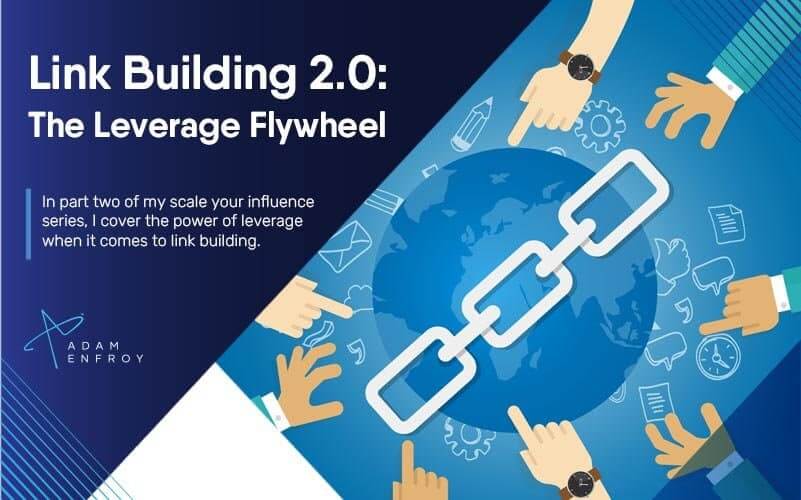How Much Does It Cost to Create an Online Course? (2024)

Dealing with online course costs doesn’t have to be scary.
In fact, making decisions becomes much easier when you know your numbers. Specifically, knowing your projected income and expenses will help you plan better.
In this post, I answer the big question: how much does it cost to plan and shoot an online course?
I wrote this article based on what I learned from building two full-blown successful courses (and enrolling thousands of students).
In this article, I cover:
- the main areas where you’ll spend money when building your course (some are less obvious than others)
- the cost ranges involved (based on industry standards)
- tips to help you keep costs down where possible (the most expensive option isn’t always the best one)
- costs that most people don’t even consider (these can be business killers if you don’t plan for them properly).
The Cost To Create An Online Course
Let’s consider the different aspects of creating an online course and their respective costs.
Online Course Development Costs
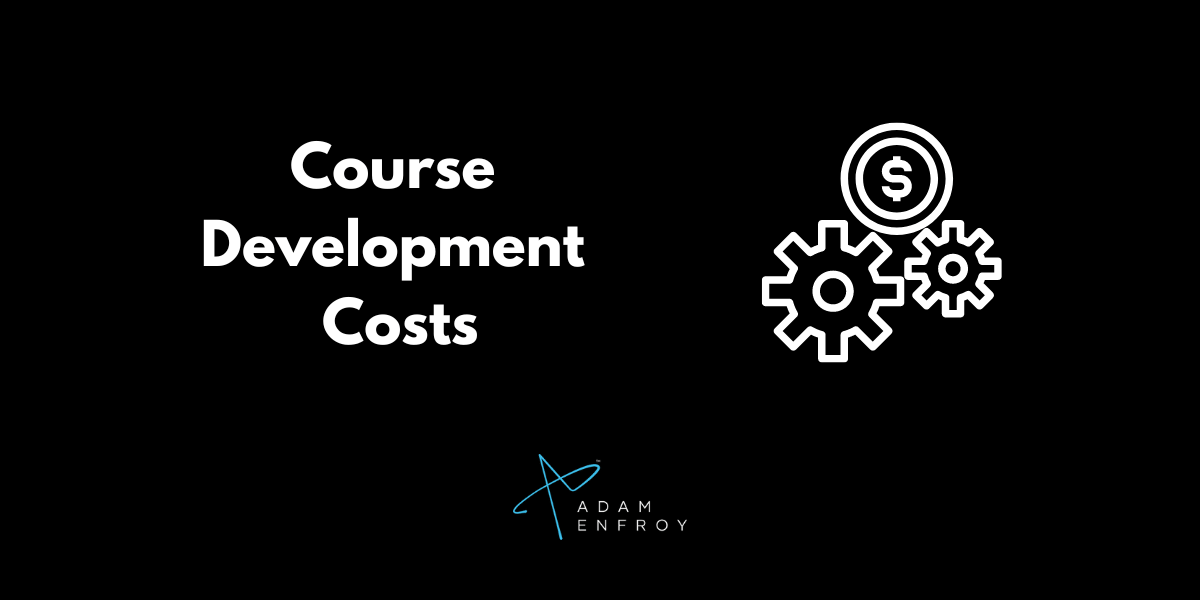
Course development is the stage where you’ll spend the most money when building your course.
Taking the time and investing the required resources means:
- you’ll need to edit the final draft less than if you rushed this process (or went with cheap solutions)
- you’ll generally end up with a better-polished product
- you won’t have to rely on doing all the marketing yourself. Your students will spread the word based on the results they get from your course.
So what are the actual costs involved?
Content Research, Outlining And Scripting
The first step is to consider the extent of the research you need to do. If you’re responsible for all the moving parts, you must do lots of research.
Aspects like:
- Target audience
- Competitor analysis
- Expertise and knowledge of the subject matter
- Identifying learning objectives
- Creating engaging activities and assessments
Compare this to someone who will only be responsible for marketing the course. In this case, much less research is involved.
Say you have a partner who is a subject matter expert. The person lives and breathes the topic in question. In this case, they don’t need to do the research you’d have to do if you were responsible for all the steps.
I’ll dive deeper into this later in this article.
Just consider that doing the research will cost you lots of time. Hiring a freelancer to do the research can cost between $20 and $50 per hour. The type of research needed also plays a vital role.
Some topics are harder to research or need more expertise. The higher this factor, the more you’ll have to pay the researcher.
My advice?
Even if you create, market, and sell the course yourself, finding a subject matter expert at this stage will pay back multiple times later.
You can also use AI tools to help with research. For example, if you’re looking for stats regarding the people interested in your topic, ChatGPT can come in handy.
More specialized tools (like Perplexity) are also geared towards finding factual data.
Once you’ve done your research, I suggest creating the outline for your course materials (one of the critical steps in creating an online course) before continuing the course development process.
Design And Multimedia Elements
Professional images and designs add to the value of your course.
While you might not want to create the finalized graphics and images at the beginning of your creation process, getting a few drafts designed is a good idea.
Having an idea of the final product’s appearance is crucial for ensuring progress.
There are various elements to consider at this stage:
- Cover images
- Interactive elements (like videos, animations, and quizzes)
- Branding elements including color schemes and logos
- Stock photos and videos
- Graphs and charts to visually represent data
Each of these comes at different costs.
AI image generators can help with most of this. I suggest using different tools to see what outputs you can generate.
These outputs will provide a first-hand understanding of the types of images and graphics you will need for your course.
The costs of these images depend on how you generate/create them.
For example, AI image generators generally require a monthly subscription. You can expect to pay between $10 and $20 monthly for these tools.
Here are two (unedited) examples of AI image outputs for “online course cover for a course on blogging success”.
ChatGPT (DallE 3):

Jasper:

Quite different styles of outputs. Also not very polished. However, I generated these quickly and for a relatively low cost.
The aim is to have an idea of where I’m heading with my course creation process.
Getting a designer to create custom images will cost a lot more. These costs can reach hundreds of dollars depending on the complexity required and the designer’s experience.
Video Production
By now, you’ve done the research and outlined your course based on it. If you’re more of a scripted course creator, you might have created the script for your videos.
You also know what type of images you will use and what these images will look like.
The next step is to start recording your online course content. Whether it’s you or someone else who will be the face of the brand, getting clear on the video production format is crucial.
The last thing you want is to waste hours recording videos in a specific format only to find out it’s not the best type of content for your topic.
Here are some ideas:
- Screencast / presentation-style videos: Here, you’ll share your screen and run people through specific processes you developed. The idea is to give an over-the-shoulder look at what you’re doing. People can follow along and learn from your examples. This is great for courses involving software tutorials, website walkthroughs, or any other type of online demonstration. Recording costs are generally a few hundred dollars for the software. You can look at Screenflow or Camtasia for two of the best-paid ones. The good news is that these are generally one-off costs. You can also look at OBS for free software to record your screen. With OBS, there are more technical things to set up than other software.
- Talking-head videos: This is a great option if you don’t need your audience to follow along as you share your screen and are happy to “talk to a camera” as you record your course. All you need is a camera (even a high-quality smartphone will do) and a good microphone. The cost for these depends on your budget. There are entry-level, middle-range, and top-of-the-line tools for every budget.
- Lighting: You might want to invest in great lighting when you’re on camera (talking heads or screencasts with face recordings). Having students able to see you in the best possible light (pun intended) adds to the professional aspect of your online course. Better video quality means you can charge more per student. In terms of costs, there are plenty of DIY home studio lighting setups. A simple tripod light can cost less than $100 and is a great way to get good light on a budget. However, similar to cameras and microphones, you can invest lots of money into advanced lighting.
Considering video editing software is also essential. You can’t sell online courses without editing the videos you record.
You’ll make mistakes when recording unless you’re very well-trained on camera. It’s crucial to use a video editor to polish your videos.
A tool like Capcut is excellent for easy video editing. You can also go for something like Davinci Resolve. Both of these tools have free versions that will get the job done.
Adobe Premiere is a paid solution (costs $22. 99/mo) with a steep learning curve. It’s also the tool that video editing professionals use.
Platform and Operational Costs
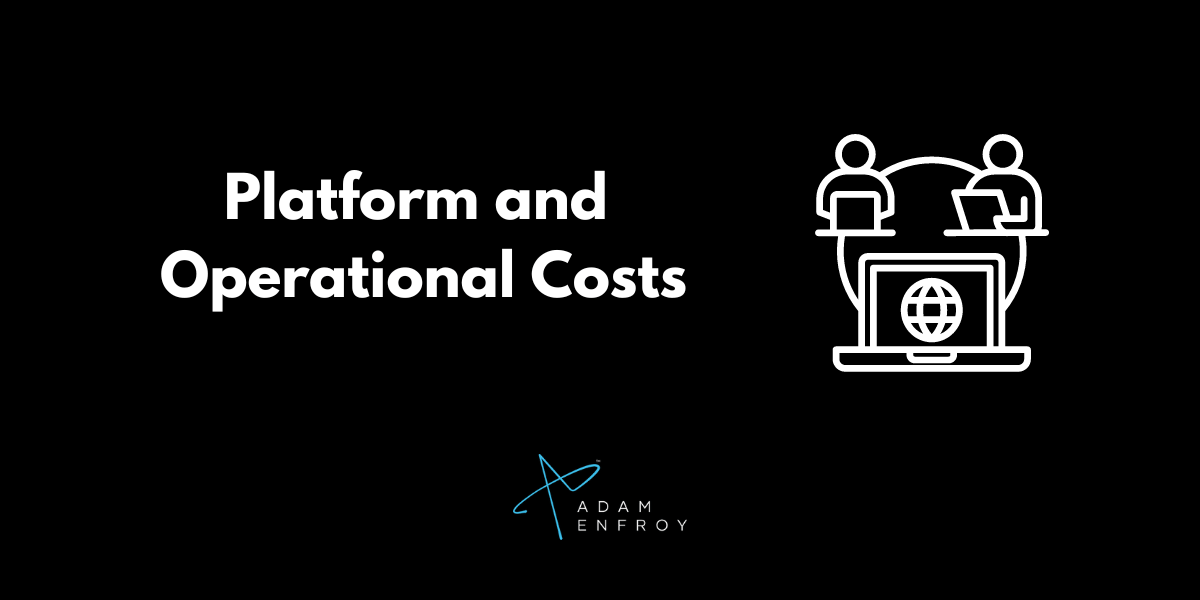
After recording your course (which takes the most time when becoming a course creator), you must put it online. Here’s what is involved in this process and the typical costs associated.
Learning Management System
Your course platform allows students to find, buy, and access your online course.
The options with online course platforms vary. Some platforms are very basic. They’re essentially private online storage spaces with video playback features – and nothing else.
Conversely, some platforms offer everything a course creator needs (and even features that are probably overkill).
I’m talking:
- pre-course landing pages
- sales pages
- payment processing
- course video playback
- community building
- quiz building
- email marketing
- reactivation campaigns
- and much more.
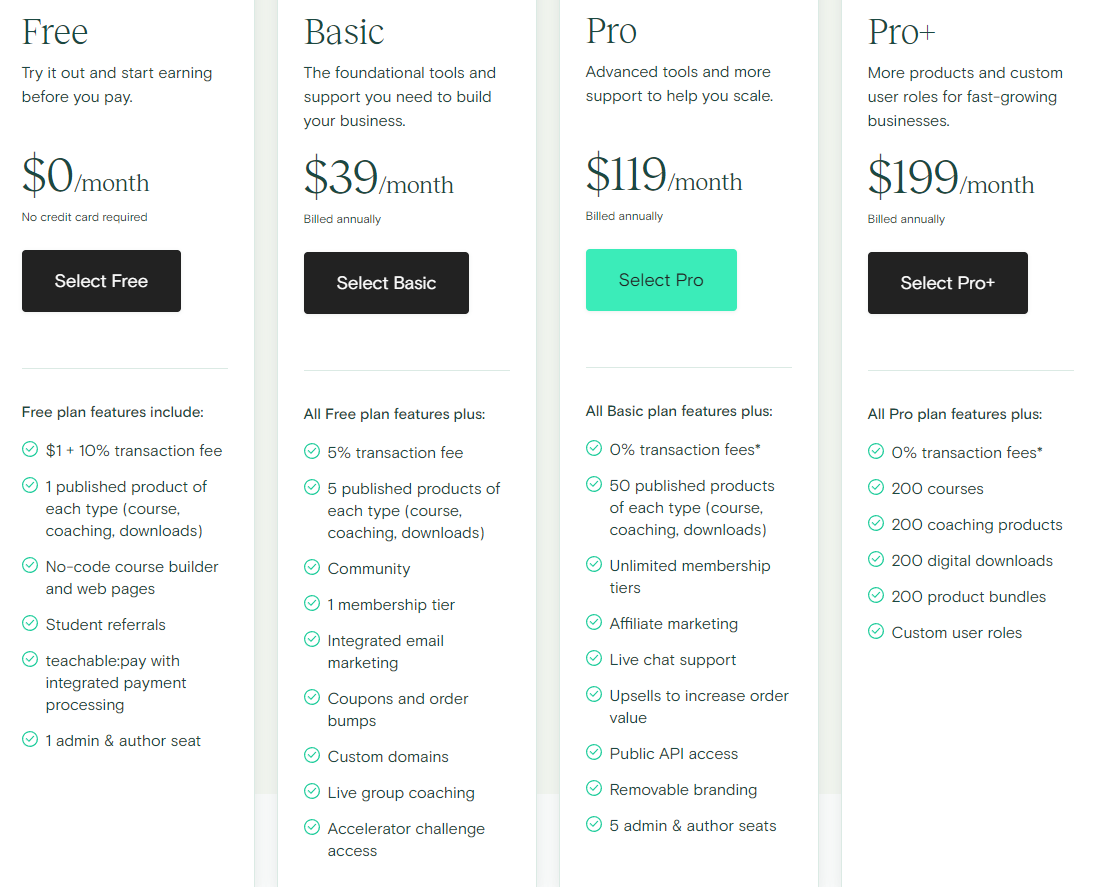
Source: teachable.com
You can expect to pay anywhere between $39 (this seems to be the average lowest entry point) to hundreds of dollars per month. It all depends on the features.
Some of the top platforms include:
- Teachable
- Thinkific
- Learnworlds
I highly recommend listing the features needed before exploring online course platforms. If you don’t, you might go deeper and deeper into the rabbit hole (of platform features) without getting any clearer on what’s best for you.
For more information, read about the best online course platforms.
Domain Registration
Your chosen course platform will allow students to access your course using their subdomain.
Imagine the platform you use is called “OnlinePlatform.com”.
On the platform, your username is called “NewOnlineTutor”.
Therefore, you’ll get this link for potential students to access your course:
newonlinetutor.onlineplatform.com
That is one ugly link. It’s also tough to remember for future students. This is where using a proper domain comes in handy.
You can register a domain like thebestonlinecourseever.com and use that to allow students to access your course.
This also makes your course (and brand) look much more professional.
Different domain registrars will charge various amounts when registering your domain. However, this shouldn’t exceed a few tens of dollars yearly. The average cost for a domain ranges between $10 and $20 yearly.
There is an exception. If you go for a unique domain, costs can increase A LOT.
In this case, uniqueness can mean different things. It could be a domain name that many people want, is very rare, or is a one-word domain.
Fun fact: the most expensive domain in history was cars.com. It cost $872 million to buy. You’ll probably want to go for something cheaper.
Optional Costs
Before you launch your course, you might want to invest money into a few other aspects.
Two of the most important might be:
- Sales page copywriting and design: Copywriting is the skill of using words to sell products online. Unless you have this skill, you might find it challenging to put the actual value of what you’re selling into words. You might know exactly what someone will get after taking your course. However, putting these intangible ideas into words (and doing it effectively) might be difficult. In this case, investing in copywriting is a good move. You can also invest part of your course budget into sales page design. This ensures potential students experience the best first impression when landing on your course sales page.
- Course setup: You have two choices if you’re using a complex online learning platform. You could either understand how the platform works (along with all its functionality) or hire someone to do the job for you. Both options work—you just need to decide whether it’s worth doing the setup yourself or hiring someone.
The costs for these two items vary. For sales page copywriting and design, expect to pay a few hundred to a few thousand dollars.
For course setup, it depends on:
- the platform
- the features you need
- how experienced the person doing the work is.
Marketing and Promotion
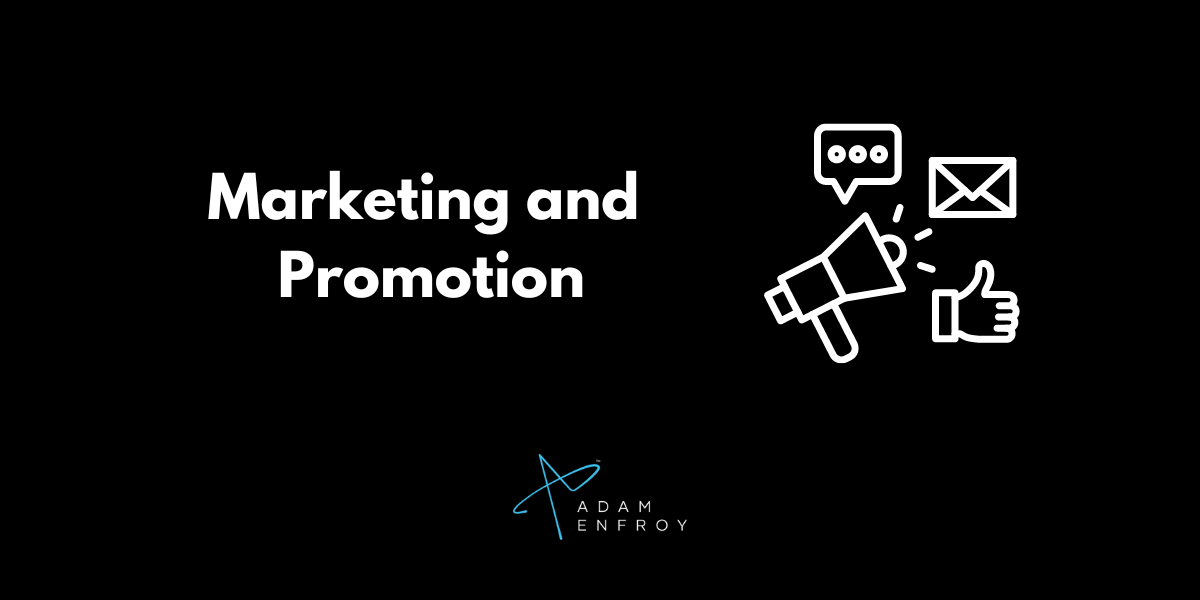
Many would-be course creators stop at the previous stage.
They assume that “if they build the course, people will come”. This might have been true in the past (when competition wasn’t as fierce). However, today, things aren’t that simple.
While you might be the exception to the rule (and find overnight success with your first course), marketing and promotion are fundamental to your online success.
Each marketing strategy has costs. Understanding these costs (and what’s worth paying—either in time or money) is crucial.
Here are the most efficient methods for informing future students about your course.
SEO Blogging
If you already have a blog following, this is probably the best way to inform people about your online course. The reason? It doesn’t cost anything to let people know.
You simply:
- create a new post
- write up a new article about the online course
- define who the course is for
- the problems it will help them solve
- publish the post.
However, this will only work if you already have a blog online and people know about it.
If you don’t, setting one up and starting to publish articles is a great idea.
My Blog Growth Engine course provides all the details if you want to learn more about this.
The costs involved with blogging and SEO depend on your approach. You’ll first have to set up your blog, which involves web hosting ($10-$50 per month) and buying a domain ($10- $20+ yearly).
You’ll then need to post content on it (and do it often). If you create the content yourself, you’ll have to invest time. If you outsource your content creation, the cost depends on the writer(s) you hire.
YouTube
Online content takes many forms.
One way to market your course is through your blog. You could also start a YouTube channel to help promote it.
Like blogging, it would help to have an audience following your YouTube channel.
If you already have an audience, create a walkthrough video explaining what students will get from your course. The video will humanize you as the content creator and allow you to market your course to many people.
There’s no financial cost to doing this. All it takes is the time to record the video and publish it on YouTube.
If you don’t have a YouTube channel, there’s never been a better time to start one.
You can check out YouTube Growth Engine for an in-depth look at starting a YouTube business.
Paid Social Media Advertising
Posting content and hoping for organic reach isn’t the only way to promote your course.
Social media ads are a powerful tool if you have a budget and are willing to pay for views, engagement, and clicks.
The idea is to spend a set amount of money and get a positive return on your investment. For example, your ads are profitable if you spend $100 and make 1 sale (imagine you sell your course at $299).
Finding the right audience for ads could take some time. Especially if this is your first time running ads, social media algorithms need to “understand” who the best audience for your course is.
It’s essential to be patient and let the algorithms work. This means not giving up when things don’t work out immediately.
When things click, you’ll have the right audience to market to. If you want to scale, you can spend more money to reach more ideal buyers.
The cost of paid ads depends on your industry, competitors’ ad budget, and the social media platform you’re using.
Email Marketing
Building an email list and marketing your course to interested people is one of the best business decisions you can make.
Generally, you’ll offer people something of value (called a lead magnet) to get their contact details. These details usually include their name and email address.
You won’t need to rely on third-party channels to reach your audience when you can contact people directly. In other words, you won’t have to pay to get in front of the right people.
Instead, you can write an email, load it into your email autoresponder platform and send it to your audience.
A word of warning: It’s important not to just send email promotions. You still need to provide your audience with valuable content. Then, on certain occasions, you can be more promotional.
What about costs? Sending emails doesn’t cost much.
You’ll have to pay for the email platform (this generally costs $20-$50+ per month – depending on features). Some platforms also charge based on the number of contacts on your list.
In other words, someone with a 1000-person email list will pay more than someone with a 100.
Influencer Collaboration
Partnering with the right people in your niche is a great way to promote your online course.
When planning collaborations, it’s crucial to find people that:
- already have an audience that knows, likes, and trusts them
- speak about topics that are related to your online course topic.
When collaborating with influencers, you’re essentially “borrowing” someone else’s audience. If the audience doesn’t trust the influencer, you’ll find it difficult to succeed.
Even if the audience wholly believes in the influencer, the topics they’re interested in must be relevant to those you speak about. If not, chances are your promotions will fail.
To get started with influencer collaboration, you’ll need to:
- Make a list of influencers to potentially work with (based on their topics and audience)
- Build a relationship with them before making the ask. Comment on their online content, find ways to provide value, buy their courses, etc. The idea is to find ways to add value to their work.
- Next, make the ask. Tell them you have an online course that would greatly match their audience. Ask if they’re open to promoting it. Be specific about how you will compensate them when their people sign up for your course. Also, be specific about how your online course will benefit their audience. This is crucial for a long-term relationship.
- Run the promotion. Send the emails/run the social media campaigns etc.
- After, analyze the results and find ways to iterate. Do this whether you intend to work with the same influencer again or not. There’s always something to learn from the experience and the data.
Influencer collaborations can cost time and money. How much depends on the agreement you have in place.
What’s great here is that everything is open to negotiation. You also don’t have to only offer money.
If you have a skill (that is of value to the influencer), you can use it instead of money.
Additional Considerations
Creating (and marketing) an online course involves lots of investment.
Whether that’s time, money, or expertise, it’s crucial to understand what you’re getting into.
Considering these expenses, putting the correct price tag on your course is crucial. You don’t want to spend time creating a course and then sell it for (close to) nothing.
Remember that people value free stuff much less than what they pay for. Your online course’s price should accurately reflect the value it provides.
Next, consider that all course creation expenses generally have cheaper alternatives. For example, you can use your smartphone camera instead of a high-end film-production camera.
Will the video quality be the same? Probably not.
However, your course’s value doesn’t depend solely on its video quality. As long as the quality is good enough to convey your message, you can probably proceed. After all, you’re not creating a Hollywood movie.
The same applies to other tools and platforms.
You could invest hundreds of dollars into the best screen recording software to make recording the easiest process possible. Alternatively, you could use free solutions and take on a longer learning curve.
It depends on how much time and/or money you’re willing to spend and the balance between the two.
Another key consideration is scaling. If your course gains popularity, what other valuable information can you sell your audience?
Is it possible to create more content and provide more value? Or are you forcing yourself into a corner when creating your first course?
If creating more (higher-priced) courses after your first one is challenging, you might want to rethink your topic.
What you want is the ability to get people to pay more money for even better (and more valuable) solutions.
These solutions could include more courses, different formats (like one-to-one coaching, group workshops, ebooks, video courses, etc) or even various levels of help.
If your entry-level course is delivered in a DIY (do it yourself) format, you’ll want solutions that involve more of a DWY (done with you) or even a DFY (done for you) model.
Different models = higher price points you can charge.
The possibility of charging more in the future (while providing more value) will help offset your course costs and increase your profits.
Conclusion
Building and selling online courses requires strategic planning. Every step involves making choices that impact the cost and quality of the course.
Investing wisely in the course-building process helps you build a course your audience loves and stands out in a crowded marketplace.
By following the above guide, you’ll make intelligent decisions that lead to long-term results.
Further reading on AdamEnfroy.com: Still unsure whether to create an online course? Here are the pros and cons of online courses today.
You can also use artificial intelligence to help reduce some of the course creation costs.
You can also read more about the process of selling online courses.





